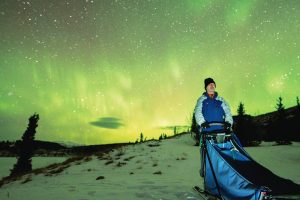By David Fleet
dfleet@mihomepaper.com
Whitehorse — Consider riding a sled pulled behind six Alaskan Huskies across the Yukon wilderness in sub zero temperatures under a night sky of the northern lights.
sub zero temperatures under a night sky of the northern lights.
The freezing yet stunning experience was that of Brandon Township resident Heath Zietz who earlier this month made the 3,100 mile trek to Whitehorse, Yukon for a five-day dog sled trip through the frozen Canadian wilderness. The 112 mile trip featured two nights in a tent along the historic Yukon Trail, a Klondike Gold Rush-era transportation route between Whitehorse and Dawson City, Yukon.
“It was 22 degrees below zero the night we were out,” said Zietz. “The dogs pulled for about 30 miles per day and did not seem all that tired at the end of the day. This trail was more technical than others I’ve completed due to the mountainous terrain.”
Zietz, who had six previous mushing trips, was guided this time by Whitehorse-based Muktuk Adventures. The outfitters are unique in that they rescue sled dogs that are no longer actively racing but still enjoy running and work as a team. Since 2012 Muktuk has rescued more than 60 dogs and today has 118 dogs that pull guests on trails in the area.
“These dogs were not the best for racing anymore, let’s say they were the ‘C’ team of sled pulling,” he said. “They were trained to follow not lead and often did not respond all that well.”
Many of the dogs were Alaskan Huskies although some were mixed breeds. A guide went through ahead of the teams on snowmobiles with supplies including food and bales of straw for the dogs to sleep on at night.
Some of the same trails that Zietz mushed on were used for the Yukon Quest, three dog sled races traversing 100 miles, 250 miles and 450 miles for a total race of 1,0000.
“The area was very pristine wilderness although some of the trail signs were along the way,” he said. “Otherwise it was amazing wilderness.”
The sun set about 7:30 p.m. and rose about 9 a.m. each day.
“Even in the Yukon there were trails closed this year due to lack of snow,” he said. “Even the Yukon was having trouble with snow, similar to Michigan.”
Whitehorse, the provincial capital of the Yukon, is located about 700 miles south of the Arctic Circle. The northern location provided a clear vision of the aurora borealis, which Zietz photographed in the darkness with a slow 30 seconds shutter speed.
“I was lucky enough to see the auroras every night,” he said. “The guide said previous guests went out every night and never saw them, so for that matter I was very fortunate. Due to air and light pollutants it’s almost impossible to see the aurora here in Michigan.”
The photos bring out the color better the long exposure pulls out the color, he said.
“We stayed outside for about an hour each night. It was intermittent sometimes for just about 10 minuets.
“Watching it dance through the sky is amazing,” he said.
